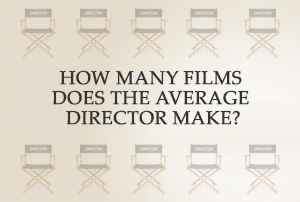 Last week on Twitter I was asked about the average director’s career and how many directors get to make a second film.
Last week on Twitter I was asked about the average director’s career and how many directors get to make a second film.
This was sparked by some research I conducted a while ago on the average careers of British writers, producers and directors, and also by my 2016 study of female directors in UK film. So I promised to return to the topic of directors’ careers and how they differ between male and female directors.
To answer the questions fully, I built up a database of all fiction films made since 1949, worldwide – a whopping 287,448 films. Usually, I focus on films that reach cinemas, but this time I wanted to cast the net as wide as possible and study the levels of production, not distribution. (You’ll find more info about the data and methodology at the end of the article).
I’m going split this research into two articles: today I’ll look at the average career of a film director and next week I’ll focus on the differing experiences of male and female directors.
There are two ways to look at today’s question:
- How many directors make a second film?
- How many directors does the average film have?
How many film directors make a second film?
Across all feature films made worldwide in the past seventy years (between 1949 and 2018), 36.5% of film directors made a second feature film. Only 8.6% made more than five, and it’s a rare club of just 134 directors (0.1%) who have directed more than 20 movies.
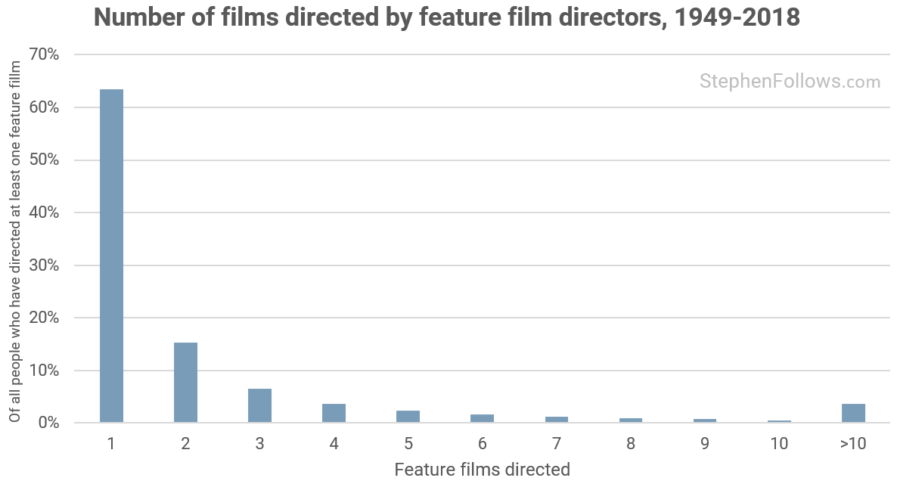
How has this changed over time?
The chart below shows the number of directors who have made a second film, shown by the year of their debut release. I.e. if their first film was released in 1992, they would show up in 1992.
We should expect the number of repeat directors to fall in the most recent years, as films can take years to get funding, filmed and finished. However, we see an almost-steady decline as far back as my time series goes.
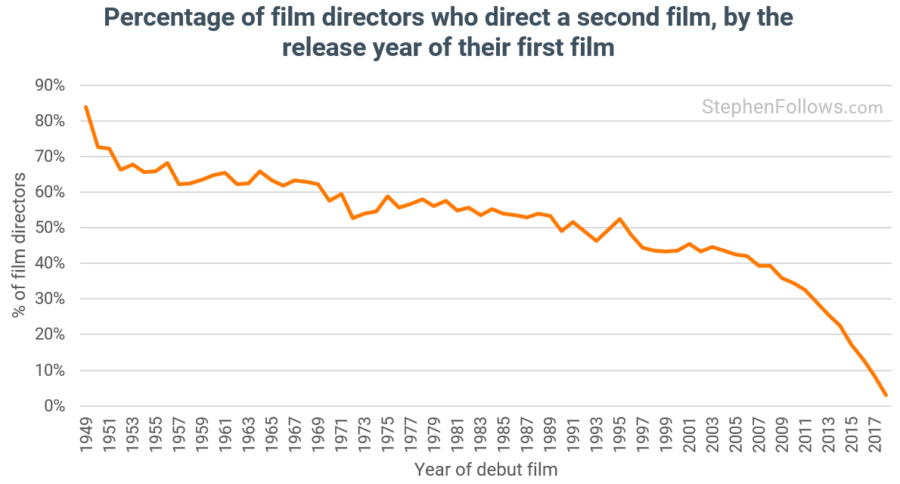
At first glance, the chart above suggests that it’s becoming ever-harder to make a second film. While that is may be true, it’s not taking into account that some the first-time directors in the last few years might yet make another film. Therefore, the chart below shows the percentage of directors who have made a second film within five years of their debut. It shows the same decline over much of the 20th century but then steadies out in the late 90s.
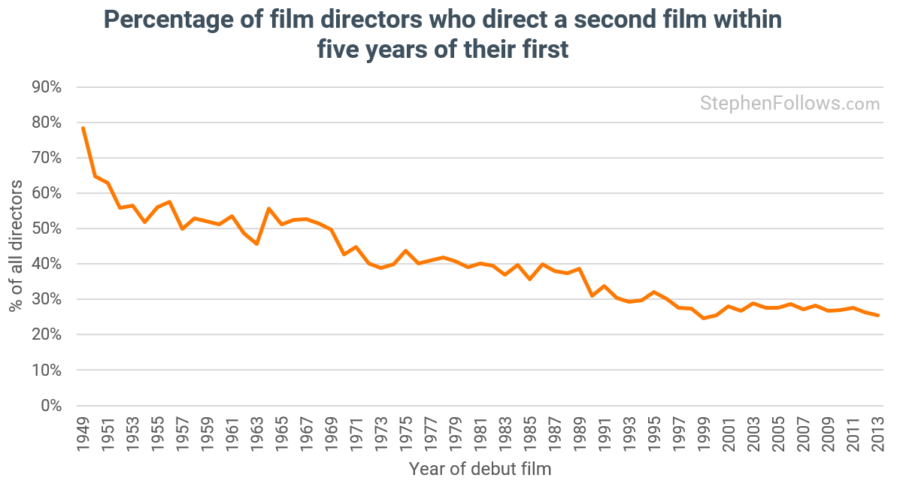
This could be read as a negative trend for directors (i.e. it’s becoming ever-harder to make a second movie) or a positive one (i.e. it reflects how the barriers to entry in the film industry are falling, meaning that directing is open to a much larger constituency of people than in the past). I’m keen to hear the thoughts and theories of readers, so leave yours in the comments below.
It’s worth noting that ‘not directing a second film’ is not the same as ‘failing to be a director’. Some one-time film directors will go on to direct other media, such as TV shows, adverts and music videos. Others may have directed as a way to launch their primary careers, such as acting or writing.
How many directors work on the average movie?
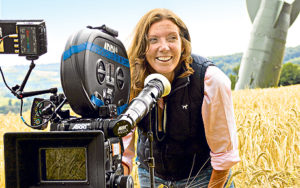 We’ve looked at the average number of movies per director, so let’s flip the question and look at the average number of directors per movie.
We’ve looked at the average number of movies per director, so let’s flip the question and look at the average number of directors per movie.
The image most people have of the role of director is that of a solitary person taking on all the directing duties. ln reality, it’s often much more of a team effort, in a few different ways:
- Fellow creatives. Directors are the head of a huge team of fellow creatives who all contribute ideas and work on the film’s overall vision.
- Second Unit Directors. There are some shots in many movies which the main director did not shoot. Typical shots include aerial footage, underwater moments or action sequences.
- Portmanteau features. A very small number of feature films are made up of sections, each directed by a different person, such as Grindhouse and Movie 43.
- Directing teams. Some films are helmed by more than one person, with directors working in a partnership or team to share the role. The Directors Guild of America (DGA) rarely allows more than one person to receive the official directing credit on a live-action movie, meaning that any film made in Hollywood under union rules is extremely unlikely to list a directing team. They make exceptions for directing partnerships if they have “a history of working together and sharing a common vision”, such as the Russo Brothers, Phil Lord and Christopher Miller and the Coen brothers. The vast majority of the films around the world are not made under DGA agreements.
In the first of those examples, each of the people involved will receive their own credit, rather than any kind of directing credit. Second Unit Directors do receive credits with the word ‘director’ in their title but are not counted as having “directed” a movie in the normal sense and consequently are not included in today’s research.
This means that when I looked at the number of directors credited on a movie, I’m tracking portmanteau films and, much more frequently, directing teams.
Across the whole dataset, 6.4% of movies were directed by more than one person. This has increased over time, with a low of 3.8% in 1972 and a high of 9.3% in 2011. 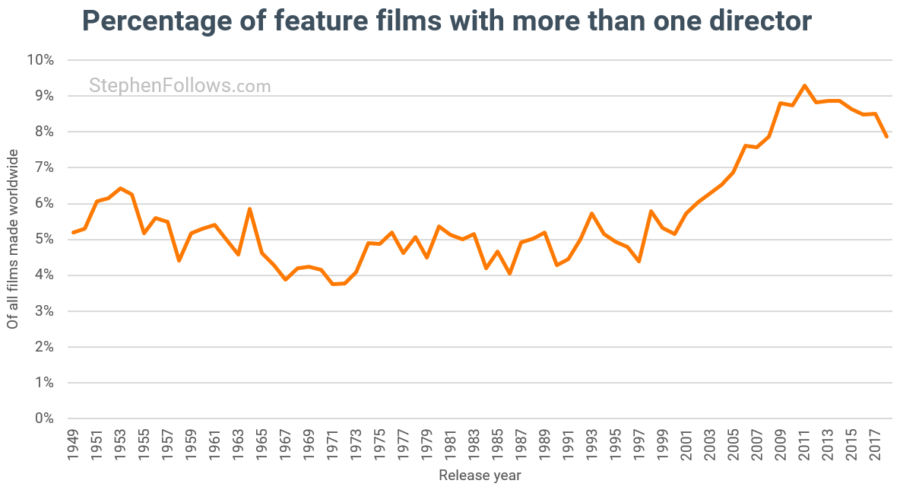
Which genres are most likely to share a directing credit?
The time-series above lumps together all feature films, so let’s see how the picture changes between genres.
Animation films stand out from the crowd, with a whopping 21.8% of them having two or more directors. The loneliest genre for directors is, rather ironically, Romance (4.9%)
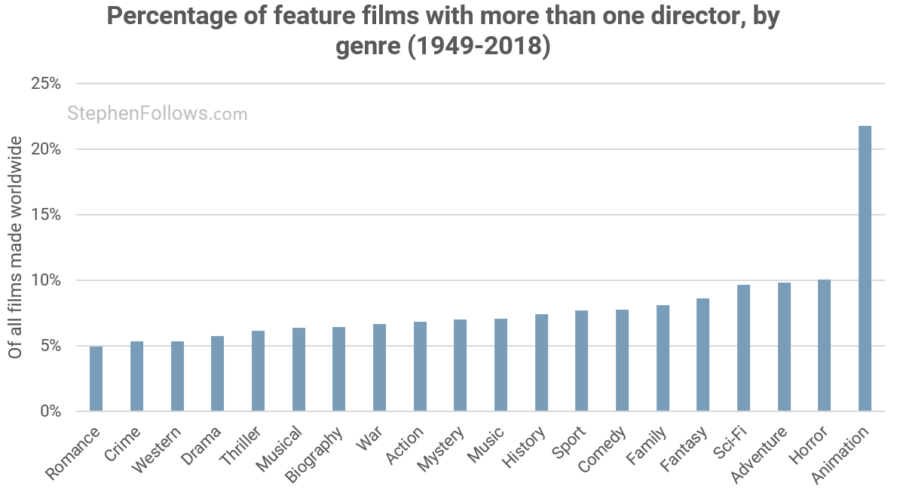
 This is likely to be down to a few factor reasons:
This is likely to be down to a few factor reasons:
- Differences in the timeframe. The job of directing a Horror film or a Thriller is very similar. However, the difference between directing a live-action and an animated movie is vast. A crucial difference is the timeframe and therefore the speed of decision-making. The average Hollywood movie takes 106 days to shoot. Everything leads up to the shoot, by which time many of the key factors are locked-in, including casting, performance, locations, camera moves, etc. Animation has a different workflow and it takes far longer to make the average movie. This means that there are fewer split-seconds where a decision will be locked in, never to be reexamined. The short-term nature of a live-action film shoot favours a singular person at the top. (I’m not claiming that animation is any easier or harder; just that the nature of decision-making differs).
- The level of control over the image. In a wholly animated film, everything has to be conceived and created from scratch and almost every single element can be altered. Compare this to a live-action film in real-world locations in which the level of control a director has seems a whole lot smaller (although still pretty daunting!) Therefore, having more than one director is a boon to help both in discussing options and making decisions.
- Industry norms. I previously mentioned the DGA’s dislike of shared credits for live-action movies. This does not extend to animated films and so shared directing credits are seen as a more normal occurrence, both within the industry and popular culture. This is a bit of a ‘chicken and egg’ situation as we cannot say whether the industry perception led to the DGA’s policy or vice versa. The DGA’s current position was announced in 1978 although the debate is much older.
Interestingly, the trend of multiple directors on Animated films is falling.
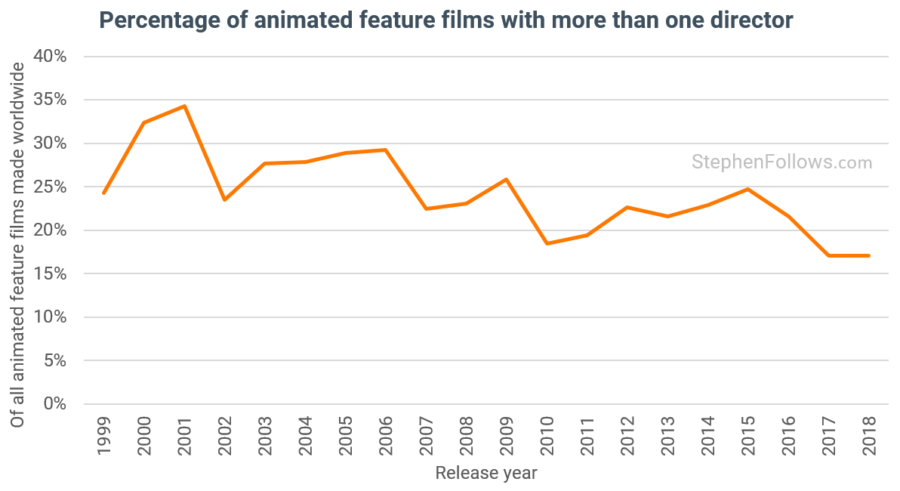
This is in sharp contrast to every other genre, which are all seeing either a rise in shared director credits or no discernable change over the past thirty years. For example, here is the trend for Dramas:
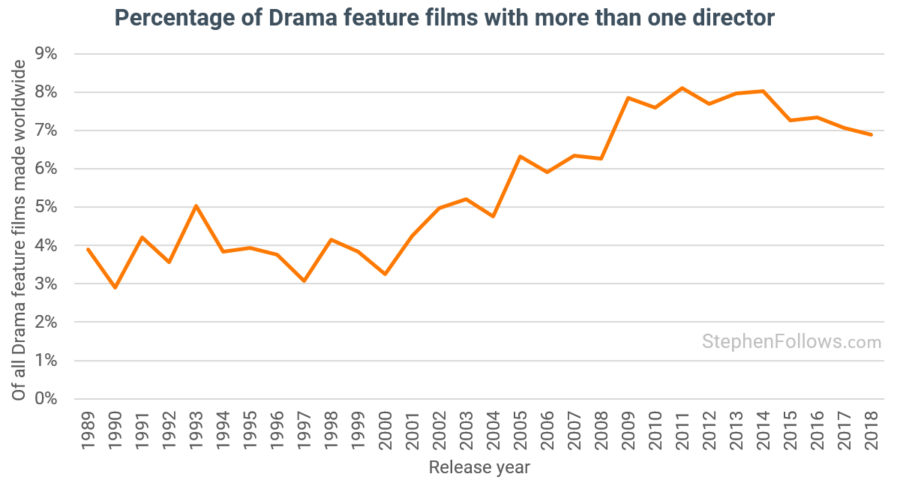
Further reading
If you have hopes of securing a directing job, whether you’re animated or not, here’s some research I conducted a few years ago, combining advice from over 100 working film directors: How to become a film director.
Notes
 The data for today’s research came from a number of places, principally IMDb, The Numbers Wikipedia, Box Office Mojo and OMDb. My dataset includes all fiction feature films made and listed on those sites.
The data for today’s research came from a number of places, principally IMDb, The Numbers Wikipedia, Box Office Mojo and OMDb. My dataset includes all fiction feature films made and listed on those sites.
Genre classifications were from IMDb, where possible.
The data for the number of directors per film includes both portmanteau films and those led by a directing team. Sadly, I can’t think of a way of reliably distinguishing these two types of movies in the dataset.
Epilogue
If you have thoughts on why today’s data looks the way it does, please do drop a comment below.
Next week, I’m going to use the same dataset to look at how the careers of directors differs between male and female directors.


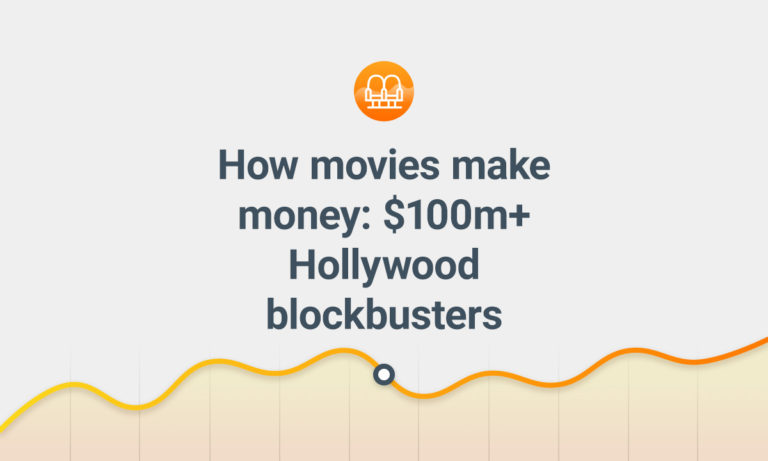


Comments
134 directors make more than 20 films? I think you should name and applaud them! There could be some interesting appearances in that list….
Well, quantity and quality are not synonymous so not all deserve applause!
Well Said! and keep up this very interesting work of yours!
Fascinating as always, Stephen! This one was very surprising to me to see how few directors go on to make multiple films.
Really interesting. Only 134 directors with over 20 films? Id be curious to know who they are too. Also, how documentary film directors play out statistically with fiction directors. Thanks for the research as always.
The negative trend shown in the percentage of directors who direct a second film is just likely to be because people who directed their first film longer ago have had more time to direct a second. A better representation might be to show the percentage of directors who direct a second film within say 5 years of their first, and only show pre-2014 otherwise you’ll get the steep dropoff at the end again? That way you’d see if there genuinely was a trend towards more directors only directing a single feature film.
A damn good point. I’ve re-crunched the data and added a new chart. Thanks for the idea.
Nice Stephen. I’ve made 4 so far – and working on my 5th – so I’m in select company! I think part of the reason for the recent dropoff is that after making one film, many people discover how difficult (and expensive) it can be and perhaps turn to other artforms. They also have run into the difficulty in distributing films and the extra funds that requires, without preparation. Films used to be very expensive to make so there was a high bar to fund and complete (also fewer makers). There were fewer films – and more got released as a percentage of those made – giving a sense of success and impetus to another film. Now it is very inexpensive to make the first film leading to more films and more makers and less success as a % of films made due to a wide variety of reasons not the least of which is there is so much noise that films need to penetrate now. Lack of first time success probably contributes do not making another film, especially for those who don’t have to make a film. As in all art forms – the ones who continue are those who cannot do anything other.
Also – would be good to see a diversity breakdown on this!
Fascinating work, Stephen. Amazing number crunching you did!
I am a screenwriter. I would love to see similar charts for writers. Curious how many fall into the “one and done” camp.
Those of us who chose to make movies (and mini series)for television were able to make dozens of films over the decades. Also, we got to make films written by first rate writers, with big stars and great character actors, and got to make them on locations around the world. It was a decision I consciously made early in my career after seeing how many years would go by between directing feature films. The irony is that today top directors go to television to make quality films. And we now have Steven Spielberg, who started in television, trying to protect the Oscars from movies for television.
The post you shared here is very informative. Thanks for writing such a great information for us.
What is your criteria for “Feature Film”? Does it have to be released theatrically, what about direct to DVD/VOD/Subscription etc? Do film festival films count? If festival films count, I would think that the number of 1 and done directors would be quite high.
Hi,
I’m currently working on a student project for a statistical learning class. I’m interested in your analysis of “How many directors make a second film?”. Mostly, because I’m doing an analysis of the Oscar’s Best Picture Nomination. From my own analysis from 2000-2016, out of the 117 nominees for Best Picture, 29 of the Directors (approximately 25%) received a previous Best Picture nomination and nearly all of them have directed previous feature films. Granted based on your 287, 448 films from 1949-2018, the Best Picture Nomination represent a 0.13% (ie 389 BPN/287,448 films).
I’m still working on numbers but it seems for a Director to get a Best Picture and/or Best Director Nomination in the Academy Awards, they would have had to direct, on average, 3 to 4 films.
I would like to hear your thoughts on those statistics.
I’ve come back to this a few times just because it kind of amazes me on one hand, but on the other I completely get it. I directed a movie in 2010 that I’m very proud of, we had a fully professional and great crew in Los Angeles with veteran producers and good working actors, but because I didn’t have top line name talent, distributors largely passed. At least, the ones that could return my investment. As a result, I spent 12 long years trying to direct again and not make the same mistake the second time around. It was an incredible feeling stepping on set again after such a long hiatus, but with the passion and determination that this would be the real start of my career and not just another false start! We shall see.